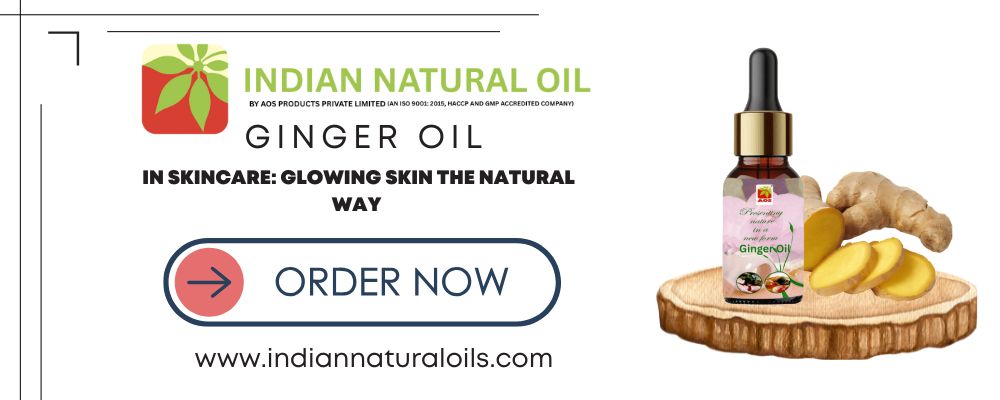
Ginger Oil in Skincare: Glowing Skin the Natural Way
In the age of clean beauty and mindful living, we’re all looking for that one natural ingredient that can do it all—soothe, heal, and bring out our inner glow. If you haven’t yet explored the skincare benefits of ginger oil, you’re in for a warm, nourishing surprise.
Known for centuries in traditional medicine, ginger oil is now making its way into skincare routines around the world. And it’s not just hype. This golden elixir is packed with skin-loving compounds that deliver visible, feel-good results—without the chemicals.
So let’s go deeper—not just into the science of ginger oil, but into how it can become a heartfelt part of your daily self-care ritual.
What Makes Ginger Oil So Special?
Ginger oil is extracted from the root of the ginger plant (Zingiber officinale) and contains potent bioactive compounds like gingerol, shogaol, and zingerone. These ingredients don’t just make ginger spicy—they’re the source of its anti-inflammatory, antioxidant, and healing powers.
But what sets ginger oil apart is how deeply human its benefits feel. This isn’t a trendy extract made in a lab—this is a root with centuries of healing wisdom, used by real people across generations.
Real Benefits, Real People: What Ginger Oil Can Do for Your Skin
1. Brightens Dull Skin
Ginger oil stimulates circulation, bringing a natural glow to tired, sluggish skin. It’s like a warm cup of tea for your face—reviving, comforting, and energizing.
Human touch: Massage it into your skin and feel your blood flow respond. Your skin doesn’t just look better—it feels more alive.
2. Fights Inflammation and Redness
Whether you struggle with acne, rosacea, or occasional irritation, ginger oil’s natural anti-inflammatory properties help calm the skin without harsh chemicals.
Human touch: Imagine your evening skincare routine as a moment of peace, not just a chore. Ginger oil helps create that calm—on your skin and in your mind.
3. Reduces the Appearance of Scars and Hyperpigmentation
Ginger oil supports skin regeneration and can help fade dark spots over time. This makes it especially beneficial for those healing from acne or sun damage.
Human touch: Think of it as a gentle reminder that healing takes time, and your skin is always capable of renewal—just like you.
4. Combats Signs of Aging
The antioxidants in ginger oil fight free radicals and promote collagen production, keeping your skin looking firm, plump, and youthful.
Human touch: Anti-aging isn’t about fighting time. It’s about embracing every stage of your life with grace—and ginger oil supports that beautifully.
How to Use Ginger Oil in Your Skincare Routine
Ginger oil is powerful, so a little goes a long way. Here’s how real people use it every day:
Facial Oil Blend
Mix 2–3 drops of ginger oil with a carrier oil (like jojoba or rosehip). Gently massage into your face after cleansing. Use daily or a few times a week.
Spot Treatment
Dab a diluted mix onto scars, dark spots, or breakouts. Be consistent, and let nature do its quiet work.
DIY Glow Mask
Apply for 10–15 minutes, then rinse. Your skin will feel fresh, nourished, and radiant.
⚠ Always patch test first. Essential oils are powerful—respect their strength.
A More Human Approach to Skincare
At the heart of any good skincare routine isn’t just the product—it’s the intention behind it. Ginger oil invites you to slow down, to feel the warmth of your own hands on your skin, and to remember that beauty isn’t about perfection. It’s about care.
This isn’t about overnight transformations or filters. It’s about real, human skin—and the ritual of loving it exactly as it is.
Final Thoughts
Ginger oil is more than just another beauty ingredient—it’s a way to return to what’s real, what’s healing, and what’s human. If your skin needs love, support, and a little glow from within, ginger oil is a beautiful, natural place to start.
So go ahead—add a few drops to your routine. Let your skin breathe, let your heart slow down, and give yourself the kind of care you’d offer to someone you love.
Because glowing skin doesn’t start with products. It starts with presence.

